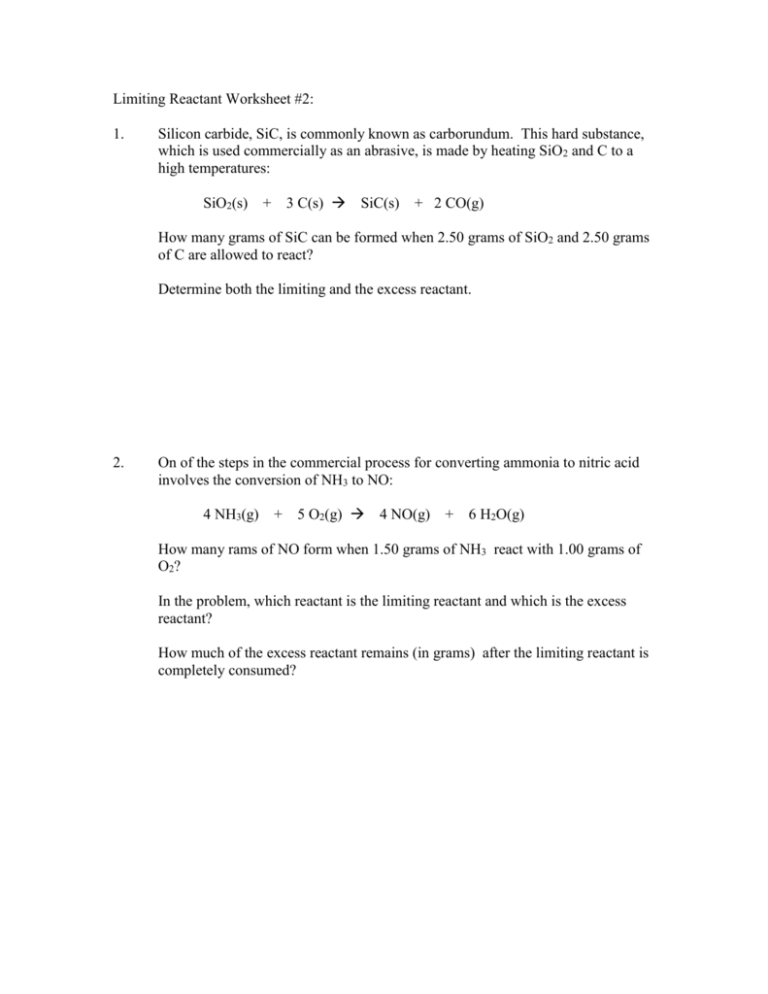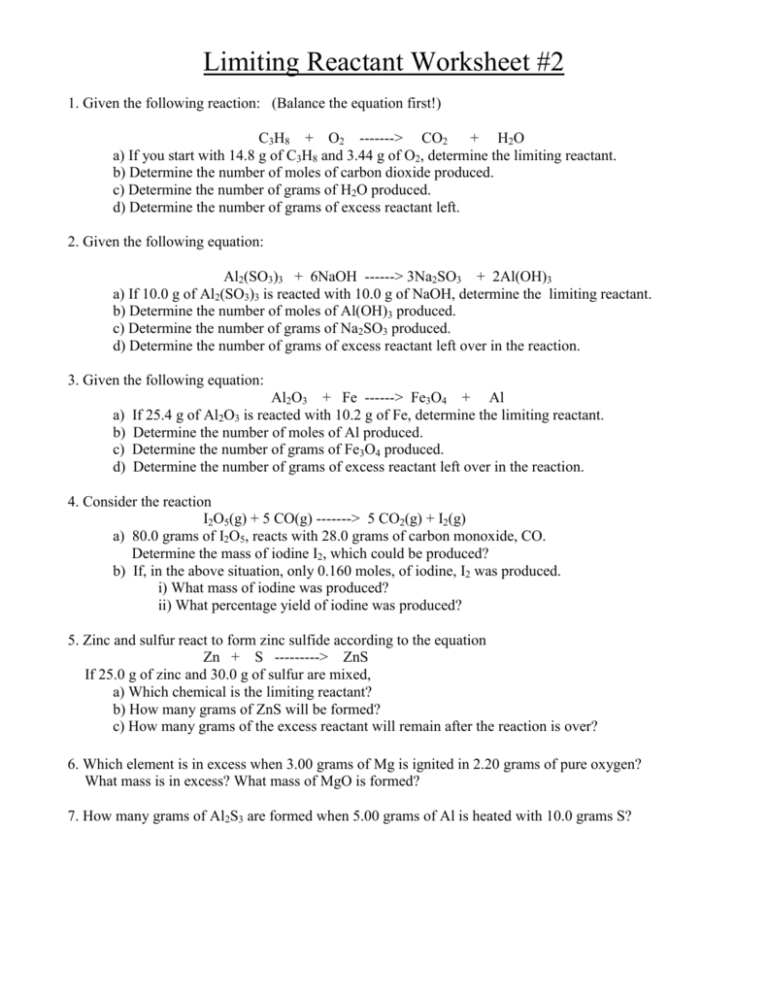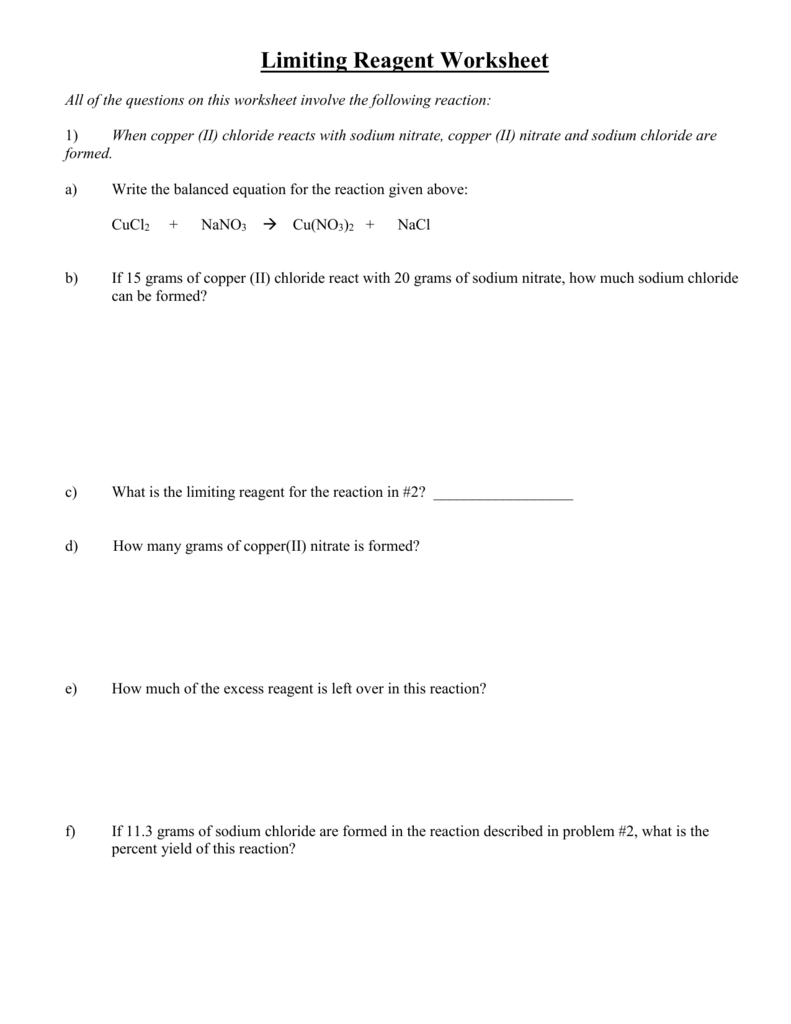Limiting Reagent Worksheet Answers - Using your knowledge of stoichiometry and limiting reagents, answer the following questions: How many moles of nh3 can be produced from the reaction of 28 g of n2 ? (b) how many moles of carbon dioxide gas (co2) will form? What is the limiting reagent in the reaction described in problem 2? Because sodium iodide is the reagent that causes 8.51 grams of sodium. (a) identify the limiting reactant. A student places 2.36 moles of acetic acid. Limiting reactant worksheet #1 1. 1) write the balanced equation for the reaction. What mass of copper is formed when 2.00 g of copper(ii) cuo + h2 → cu + h2o oxide reacts with 1.00 g of hydrogen?
What mass of copper is formed when 2.00 g of copper(ii) cuo + h2 → cu + h2o oxide reacts with 1.00 g of hydrogen? Using your knowledge of stoichiometry and limiting reagents, answer the following questions: 2 al + 6 hbr → 2 albr 3 + 3 h 2 a. (b) how many moles of carbon dioxide gas (co2) will form? What is the limiting reagent in the reaction described in problem 2? How many moles of nh3 can be produced from the reaction of 28 g of n2 ? (a) identify the limiting reactant. 1) write the balanced equation for the reaction. A student places 2.36 moles of acetic acid. Because sodium iodide is the reagent that causes 8.51 grams of sodium.
What mass of copper is formed when 2.00 g of copper(ii) cuo + h2 → cu + h2o oxide reacts with 1.00 g of hydrogen? How many moles of nh3 can be produced from the reaction of 28 g of n2 ? (a) identify the limiting reactant. Because sodium iodide is the reagent that causes 8.51 grams of sodium. 2 al + 6 hbr → 2 albr 3 + 3 h 2 a. Limiting reactant worksheet #1 1. What is the limiting reagent in the reaction described in problem 2? A student places 2.36 moles of acetic acid. 1) write the balanced equation for the reaction. (b) how many moles of carbon dioxide gas (co2) will form?
A. Chem Worksheets Chapter 10 Limiting Reactants and MIxed Mole
Limiting reactant worksheet #1 1. A student places 2.36 moles of acetic acid. 2 al + 6 hbr → 2 albr 3 + 3 h 2 a. Because sodium iodide is the reagent that causes 8.51 grams of sodium. (a) identify the limiting reactant.
SOLUTION Moles limiting reagent and molarity worksheet with answers
A student places 2.36 moles of acetic acid. Using your knowledge of stoichiometry and limiting reagents, answer the following questions: (a) identify the limiting reactant. 2 al + 6 hbr → 2 albr 3 + 3 h 2 a. Limiting reactant worksheet #1 1.
Limiting Reagent Worksheet
1) write the balanced equation for the reaction. (b) how many moles of carbon dioxide gas (co2) will form? (a) identify the limiting reactant. Using your knowledge of stoichiometry and limiting reagents, answer the following questions: 2 al + 6 hbr → 2 albr 3 + 3 h 2 a.
Limiting Reactant Worksheet 2
A student places 2.36 moles of acetic acid. What is the limiting reagent in the reaction described in problem 2? How many moles of nh3 can be produced from the reaction of 28 g of n2 ? Using your knowledge of stoichiometry and limiting reagents, answer the following questions: (b) how many moles of carbon dioxide gas (co2) will form?
Limiting Reagent Worksheet 1 Answers Printable Word Searches
2 al + 6 hbr → 2 albr 3 + 3 h 2 a. A student places 2.36 moles of acetic acid. Because sodium iodide is the reagent that causes 8.51 grams of sodium. (a) identify the limiting reactant. Using your knowledge of stoichiometry and limiting reagents, answer the following questions:
Limiting Reagent Worksheet With Answers
Limiting reactant worksheet #1 1. A student places 2.36 moles of acetic acid. How many moles of nh3 can be produced from the reaction of 28 g of n2 ? (b) how many moles of carbon dioxide gas (co2) will form? (a) identify the limiting reactant.
Limiting Reagents Worksheets
(b) how many moles of carbon dioxide gas (co2) will form? What is the limiting reagent in the reaction described in problem 2? Limiting reactant worksheet #1 1. What mass of copper is formed when 2.00 g of copper(ii) cuo + h2 → cu + h2o oxide reacts with 1.00 g of hydrogen? Using your knowledge of stoichiometry and limiting.
Limiting Reagent Problems And Answers
A student places 2.36 moles of acetic acid. What mass of copper is formed when 2.00 g of copper(ii) cuo + h2 → cu + h2o oxide reacts with 1.00 g of hydrogen? Because sodium iodide is the reagent that causes 8.51 grams of sodium. How many moles of nh3 can be produced from the reaction of 28 g of.
Limiting Reagent Worksheets
What mass of copper is formed when 2.00 g of copper(ii) cuo + h2 → cu + h2o oxide reacts with 1.00 g of hydrogen? 1) write the balanced equation for the reaction. What is the limiting reagent in the reaction described in problem 2? (b) how many moles of carbon dioxide gas (co2) will form? Using your knowledge of.
Limiting Reagent Worksheet With Answers
What is the limiting reagent in the reaction described in problem 2? What mass of copper is formed when 2.00 g of copper(ii) cuo + h2 → cu + h2o oxide reacts with 1.00 g of hydrogen? (b) how many moles of carbon dioxide gas (co2) will form? 1) write the balanced equation for the reaction. How many moles of.
A Student Places 2.36 Moles Of Acetic Acid.
How many moles of nh3 can be produced from the reaction of 28 g of n2 ? (b) how many moles of carbon dioxide gas (co2) will form? What is the limiting reagent in the reaction described in problem 2? 2 al + 6 hbr → 2 albr 3 + 3 h 2 a.
(A) Identify The Limiting Reactant.
Because sodium iodide is the reagent that causes 8.51 grams of sodium. What mass of copper is formed when 2.00 g of copper(ii) cuo + h2 → cu + h2o oxide reacts with 1.00 g of hydrogen? Using your knowledge of stoichiometry and limiting reagents, answer the following questions: Limiting reactant worksheet #1 1.









